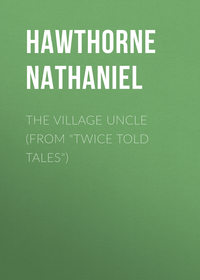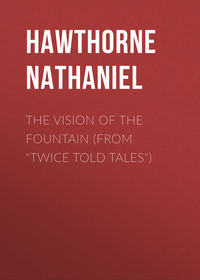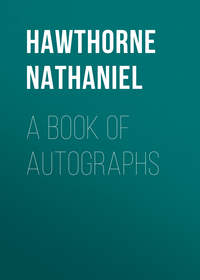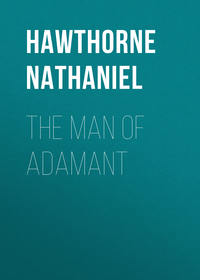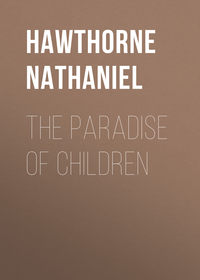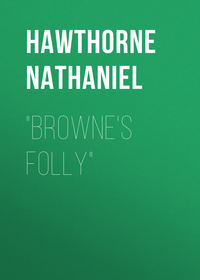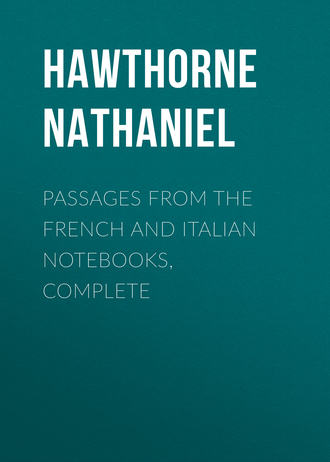 полная версия
полная версияPassages from the French and Italian Notebooks, Complete
Speaking of Jackson, and remembering Raphael's picture of Pope Julius II., the best portrait in the whole world, and excellent in all its repetitions, I wish it had been possible for Raphael to paint General Jackson!
Referring again to General Jackson's intuitions, and to Powers's idea that he was unable to render a reason to himself or others for what he chose to do, I should have thought that this very probably might have been the case, were there not such strong evidence to the contrary. The highest, or perhaps any high administrative ability is intuitive, and precedes argument, and rises above it. It is a revelation of the very thing to be done, and its propriety and necessity are felt so strongly that very likely it cannot be talked about; if the doer can likewise talk, it is an additional and gratuitous faculty, as little to be expected as that a poet should be able to write an explanatory criticism on his own poem. The English overlook this in their scheme of government, which requires that the members of the national executive should be orators, and the readiest and most fluent orators that can be found. The very fact (on which they are selected) that they are men of words makes it improbable that they are likewise men of deeds. And it is only tradition and old custom, founded on an obsolete state of things, that assigns any value to parliamentary oratory. The world has done with it, except as an intellectual pastime. The speeches have no effect till they are converted into newspaper paragraphs; and they had better be composed as such, in the first place, and oratory reserved for churches, courts of law, and public dinner-tables.
July 10th. – My wife and I went yesterday forenoon to see the Church of San Marco, with which is connected a convent of Dominicans… The interior is not less than three or four hundred years old, and is in the classic style, with a flat ceiling, gilded, and a lofty arch, supported by pillars, between the nave and choir. There are no side aisles, but ranges of shrines on both sides of the nave, each beneath its own pair of pillars and pediments. The pavement is of brick, with here and there a marble tombstone inlaid. It is not a magnificent church; but looks dingy with time and apparent neglect, though rendered sufficiently interesting by statues of mediaeval date by John of Bologna and other old sculptors, and by monumental busts and bas-reliefs: also, there is a wooden crucifix by Giotto, with ancient gilding on it; and a painting of Christ, which was considered a wonderful work in its day. Each shrine, or most of them, at any rate, had its dark old picture, and there is a very old and hideous mosaic of the Virgin and two saints, which I looked at very slightly, with the purpose of immediately forgetting it. Savonarola, the reforming monk, was a brother of this convent, and was torn from its shelter, to be subsequently hanged and burnt in the Grand Ducal Piazza. A large chapel in the left transept is of the Salviati family, dedicated to St. Anthony, and decorated with several statues of saints, and with some old frescos. When we had more than sufficiently examined these, the custode proposed to show us some frescos of Fra Angelico, and conducted us into a large cloister, under the arches of which, and beneath a covering of glass, he pointed to a picture of St. Dominic kneeling at the Cross. There are two or three others by the angelic friar in different parts of the cloister, and a regular series, filling up all the arches, by various artists. Its four-sided, cloistered walk surrounds a square, open to the sky as usual, and paved with gray stones that have no inscriptions, but probably are laid over graves. Its walls, however, are incrusted, and the walk itself is paved with monumental inscriptions on marble, none of which, so far as I observed, were of ancient date. Either the fashion of thus commemorating the dead is not ancient in Florence, or the old tombstones have been removed to make room for new ones. I do not know where the monks themselves have their burial-place; perhaps in an inner cloister, which we did not see. All the inscriptions here, I believe, were in memory of persons not connected with the convent.
A door in the wall of the cloister admitted us into the chapter-house, its interior moderately spacious, with a roof formed by intersecting arches. Three sides of the walls were covered with blessed whitewash; but on the fourth side, opposite to the entrance, was a great fresco of the Crucifixion, by Fra Angelico, surrounded with a border or pictured framework, in which are represented the heads of saints, prophets, and sibyls, as large as life. The cross of the Saviour and those of the thieves were painted against a dark red sky; the figures upon them were lean and attenuated, evidently the vague conceptions of a man who had never seen a naked figure. Beneath, was a multitude of people, most of whom were saints who had lived and been martyred long after the Crucifixion; and some of these had wounds from which gilded rays shone forth, as if the inner glory and blessedness of the holy men blazed through them. It is a very ugly picture, and its ugliness is not that of strength and vigor, but of weakness and incompetency. Fra Angelico should have confined himself to miniature heads, in which his delicacy of touch and minute labor often produce an excellent effect. The custode informed us that there were more frescos of this pious artist in the interior of the convent, into which I might be allowed admittance, but not my wife. I declined seeing them, and heartily thanked heaven for my escape.
Returning through the church, we stopped to look at a shrine on the right of the entrance, where several wax candles were lighted, and the steps of which were crowded with worshippers. It was evidently a spot of special sanctity, and, approaching the steps, we saw, behind a gilded framework of stars and protected by glass, a wooden image of the Saviour, naked, covered with spots of blood, crowned with thorns, and expressing all the human wretchedness that the carver's skill could represent. The whole shrine, within the glass, was hung with offerings, as well of silver and gold as of tinsel and trumpery, and the body of Christ glistened with gold chains and ornaments, and with watches of silver and gold, some of which appeared to be of very old manufacture, and others might be new. Amid all this glitter the face of pain and grief looked forth, not a whit comforted. While we stood there, a woman, who had been praying, arose from her knees and laid an offering of a single flower upon the shrine.
The corresponding arch, on the opposite side of the entrance, contained a wax-work within a large glass case, representing the Nativity. I do not remember how the Blessed Infant looked, but the Virgin was gorgeously dressed in silks, satins, and gauzes, with spangles and ornaments of all kinds, and, I believe, brooches of real diamonds on her bosom. Her attire, judging from its freshness and newness of glitter, might have been put on that very morning.
July 13th. – We went for the second time, this morning, to the Academy of Fine Arts, and I looked pretty thoroughly at the Pre-Raphaelite pictures, few of which are really worth looking at nowadays. Cimabue and Giotto might certainly be dismissed, henceforth and forever, without any detriment to the cause of good art. There is what seems to me a better picture than either of these has produced, by Bonamico Buffalmacco, an artist of about their date or not long after. The first real picture in the series is the "Adoration of the Magi," by Gentile da Fabriano, a really splendid work in all senses, with noble and beautiful figures in it, and a crowd of personages, managed with great skill. Three pictures by Perugino are the only other ones I cared to look at. In one of these, the face of the Virgin who holds the dead Christ on her knees has a deeper expression of woe than can ever have been painted since. After Perugino the pictures cease to be interesting; the art came forward with rapid strides, but the painters and their productions do not take nearly so much hold of the spectator as before. They all paint better than Giotto and Cimabue, – in some respects better than Perugino; but they paint in vain, probably because they were not nearly so much in earnest, and meant far less, though possessing the dexterity to express far more. Andrea del Sarto appears to have been a good painter, yet I always turn away readily from his pictures. I looked again, and for a good while, at Carlo Dolce's portrait of the Eternal Father, for it is a miracle and masterpiece of absurdity, and almost equally a miracle of pictorial art. It is the All-powerless, a fair-haired, soft, consumptive deity, with a mouth that has fallen open through very weakness. He holds one hand on his stomach, as if the wickedness and wretchedness of mankind made him qualmish; and he is looking down out of Heaven with an expression of pitiable appeal, or as if seeking somewhere for assistance in his heavy task of ruling the universe. You might fancy such a being falling on his knees before a strong-willed man, and beseeching him to take the reins of omnipotence out of his hands. No wonder that wrong gets the better of right, and that good and ill are confounded, if the Supreme Head were as here depicted; for I never saw, and nobody else ever saw, so perfect a representation of a person burdened with a task infinitely above his strength. If Carlo Dolce had been wicked enough to know what he was doing, the picture would have been most blasphemous, – a satire, in the very person of the Almighty, against all incompetent rulers, and against the rickety machine and crazy action of the universe. Heaven forgive me for such thoughts as this picture has suggested! It must be added that the great original defect in the character as here represented is an easy good-nature. I wonder what Michael Angelo would have said to this painting.
In the large, enclosed court connected with the Academy there are a number of statues, bas-reliefs, and casts, and what was especially interesting, the vague and rude commencement of a statue of St. Matthew by Michael Angelo. The conceptions of this great sculptor were so godlike that he seems to have been discontented at not likewise possessing the godlike attribute of creating and embodying them with an instantaneous thought, and therefore we often find sculptures from his hand left at the critical point of their struggle to get out of the marble. The statue of St. Matthew looks like the antediluvian fossil of a human being of an epoch when humanity was mightier and more majestic than now, long ago imprisoned in stone, and half uncovered again.
July 16th. – We went yesterday forenoon to see the Bargello. I do not know anything more picturesque in Florence than the great interior court of this ancient Palace of the Podesta, with the lofty height of the edifice looking down into the enclosed space, dark and stern, and the armorial bearings of a long succession of magistrates carved in stone upon the walls, a garland, as it were, of these Gothic devices extending quite round the court. The best feature of the whole is the broad stone staircase, with its heavy balustrade, ascending externally from the court to the iron-grated door in the second story. We passed the sentinels under the lofty archway that communicates with the street, and went up the stairs without being questioned or impeded. At the iron-grated door, however, we were met by two officials in uniform, who courteously informed us that there was nothing to be exhibited in the Bargello except an old chapel containing some frescos by Giotto, and that these could only be seen by making a previous appointment with the custode, he not being constantly on hand. I was not sorry to escape the frescos, though one of them is a portrait of Dante.
We next went to the Church of the Badia, which is built in the form of a Greek cross, with a flat roof embossed and once splendid with now tarnished gold. The pavement is of brick, and the walls of dark stone, similar to that of the interior of the cathedral (pietra serena), and there being, according to Florentine custom, but little light, the effect was sombre, though the cool gloomy dusk was refreshing after the hot turmoil and dazzle of the adjacent street. Here we found three or four Gothic tombs, with figures of the deceased persons stretched in marble slumber upon them. There were likewise a picture or two, which it was impossible to see; indeed, I have hardly ever met with a picture in a church that was not utterly wasted and thrown away in the deep shadows of the chapel it was meant to adorn. If there is the remotest chance of its being seen, the sacristan hangs a curtain before it for the sake of his fee for withdrawing it. In the chapel of the Bianco family we saw (if it could be called seeing) what is considered the finest oil-painting of Fra Filippo Lippi. It was evidently hung with reference to a lofty window on the other side of the church, whence sufficient light might fall upon it to show a picture so vividly painted as this is, and as most of Fra Filippo Lippi's are. The window was curtained, however, and the chapel so dusky that I could make out nothing.
Several persons came in to say their prayers during the little time that we remained in the church, and as we came out we passed a good woman who sat knitting in the coolness of the vestibule, which was lined with mural tombstones. Probably she spends the day thus, keeping up the little industry of her fingers, slipping into the church to pray whenever a devotional impulse swells into her heart, and asking an alms as often as she sees a person of charitable aspect.
From the church we went to the Uffizi gallery, and reinspected the greater part of it pretty faithfully. We had the good fortune, too, again to get admittance into the cabinet of bronzes, where we admired anew the wonderful airiness of John of Bologna's Mercury, which, as I now observed, rests on nothing substantial, but on the breath of a zephyr beneath him. We also saw a bronze bust of one of the Medici by Benvenuto Cellini, and a thousand other things the curiosity of which is overlaid by their multitude. The Roman eagle, which I have recorded to be about the size of a blackbird, I now saw to be as large as a pigeon.
On our way towards the door of the gallery, at our departure, we saw the cabinet of gems open, and again feasted our eyes with its concentrated brilliancies and magnificences. Among them were two crystal cups, with engraved devices, and covers of enamelled gold, wrought by Benvenuto Cellini, and wonderfully beautiful. But it is idle to mention one or two things, when all are so beautiful and curious; idle, too, because language is not burnished gold, with here and there a brighter word flashing like a diamond; and therefore no amount of talk will give the slightest idea of one of these elaborate handiworks.
July 27th. – I seldom go out nowadays, having already seen Florence tolerably well, and the streets being very hot, and myself having been engaged in sketching out a romance [The Marble Faun. – ED.], which whether it will ever come to anything is a point yet to be decided. At any rate, it leaves me little heart for journalizing and describing new things; and six months of uninterrupted monotony would be more valuable to me just now, than the most brilliant succession of novelties.
Yesterday I spent a good deal of time in watching the setting out of a wedding party from our door; the bride being the daughter of an English lady, the Countess of – . After all, there was nothing very characteristic. The bridegroom is a young man of English birth, son of the Countess of St. G – , who inhabits the third piano of this Casa del Bello. The very curious part of the spectacle was the swarm of beggars who haunted the street all day; the most wretched mob conceivable, chiefly women, with a few blind people, and some old men and boys. Among these the bridal party distributed their beneficence in the shape of some handfuls of copper, with here and there a half-paul intermixed; whereupon the whole wretched mob flung themselves in a heap upon the pavement, struggling, lighting, tumbling one over another, and then looking up to the windows with petitionary gestures for more and more, and still for more. Doubtless, they had need enough, for they looked thin, sickly, ill-fed, and the women ugly to the last degree. The wedding party had a breakfast above stairs, which lasted till four o'clock, and then the bridegroom took his bride in a barouche and pair, which was already crammed with his own luggage and hers… He was a well-looking young man enough, in a uniform of French gray with silver epaulets; more agreeable in aspect than his bride, who, I think, will have the upper hand in their domestic life. I observed that, on getting into the barouche, he sat down on her dress, as he could not well help doing, and received a slight reprimand in consequence. After their departure, the wedding guests took their leave; the most noteworthy person being the Pope's Nuncio (the young man being son of the Pope's Chamberlain, and one of the Grand Duke's Noble Guard), an ecclesiastical personage in purple stockings, attended by two priests, all of whom got into a coach, the driver and footmen of which wore gold-laced cocked hats and other splendors.
To-day I paid a short visit to the gallery of the Pitti Palace. I looked long at a Madonna of Raphael's, the one which is usually kept in the Grand Duke's private apartments, only brought into the public gallery for the purpose of being copied. It is the holiest of all Raphael's Madonnas, with a great reserve in the expression, a sense of being apart, and yet with the utmost tenderness and sweetness; although she drops her eyelids before her like a veil, as it were, and has a primness of eternal virginity about the mouth. It is one of Raphael's earlier works, when he mixed more religious sentiment with his paint than afterwards. Perugino's pictures give the impression of greater sincerity and earnestness than Raphael's, though the genius of Raphael often gave him miraculous vision.
July 28th. – Last evening we went to the Powers's, and sat with them on the terrace, at the top of the house, till nearly ten o'clock. It was a delightful, calm, summer evening, and we were elevated far above all the adjacent roofs, and had a prospect of the greater part of Florence and its towers, and the surrounding hills, while directly beneath us rose the trees of a garden, and they hardly sent their summits higher than we sat. At a little distance, with only a house or two between, was a theatre in full action, the Teatro Goldoni, which is an open amphitheatre, in the ancient fashion, without any roof. We could see the upper part of the proscenium, and, had we been a little nearer, might have seen the whole performance, as did several boys who crept along the tops of the surrounding houses. As it was, we heard the music and the applause, and now and then an actor's stentorian tones, when we chose to listen. Mrs. P – and my wife, U – and Master Bob, sat in a group together, and chatted in one corner of our aerial drawing-room, while Mr. Powers and myself leaned against the parapet, and talked of innumerable things. When the clocks struck the hour, or the bells rang from the steeples, as they are continually doing, I spoke of the sweetness of the Florence bells, the tones of some of them being as if the bell were full of liquid melody, and shed it through the air on being upturned. I had supposed, in my lack of musical ear, that the bells of the Campanile were the sweetest; but Mr. Powers says that there is a defect in their tone, and that the bell of the Palazzo Vecchio is the most melodious he ever heard. Then he spoke of his having been a manufacturer of organs, or, at least, of reeds for organs, at one period of his life. I wonder what he has not been! He told me of an invention of his in the musical line, a jewsharp with two tongues; and by and by he produced it for my inspection. It was carefully kept in a little wooden case, and was very neatly and elaborately constructed, with screws to tighten it, and a silver centre-piece between the two tongues. Evidently a great deal of thought had been bestowed on this little harp; but Mr. Powers told me that it was an utter failure, because the tongues were apt to interfere and jar with one another, although the strain of music was very sweet and melodious – as he proved, by playing on it a little – when everything went right. It was a youthful production, and he said that its failure had been a great disappointment to him at the time; whereupon I congratulated him that his failures had been in small matters, and his successes in great ones.
We talked, furthermore, about instinct and reason, and whether the brute creation have souls, and, if they have none, how justice is to be done them for their sufferings here; and Mr. Powers came finally to the conclusion that brutes suffer only in appearance, and that God enjoys for them all that they seem to enjoy, and that man is the only intelligent and sentient being. We reasoned high about other states of being; and I suggested the possibility that there might be beings inhabiting this earth, contemporaneously with us, and close beside us, but of whose existence and whereabout we could have no perception, nor they of ours, because we are endowed with different sets of senses; for certainly it was in God's power to create beings who should communicate with nature by innumerable other senses than those few which we possess. Mr. Powers gave hospitable reception to this idea, and said that it had occurred to himself; and he has evidently thought much and earnestly about such matters; but is apt to let his idea crystallize into a theory, before he can have sufficient data for it. He is a Swedenborgian in faith.
The moon had risen behind the trees, while we were talking, and Powers intimated his idea that beings analogous to men – men in everything except the modifications necessary to adapt them to their physical circumstances – inhabited the planets, and peopled them with beautiful shapes. Each planet, however, must have its own standard of the beautiful, I suppose; and probably his sculptor's eye would not see much to admire in the proportions of an inhabitant of Saturn.
The atmosphere of Florence, at least when we ascend a little way into it, suggests planetary speculations. Galileo found it so, and Mr. Powers and I pervaded the whole universe; but finally crept down his garret-stairs, and parted, with a friendly pressure of the hand.
VILLA MONTANTO. MONTE BENI
August 2d. – We had grown weary of the heat of Florence within the walls… there being little opportunity for air and exercise except within the precincts of our little garden, which, also, we feared might breed malaria, or something akin to it. We have therefore taken this suburban villa for the two next months, and, yesterday morning, we all came out hither. J – had preceded us with B. P – . The villa is on a hill called Bellosguardo, about a mile beyond the Porta Romana. Less than half an hour's walk brought us, who were on foot, to the iron gate of our villa, which we found shut and locked. We shouted to be let in, and while waiting for somebody to appear, there was a good opportunity to contemplate the external aspect of the villa. After we had waited a few minutes, J – came racing down to the gate, laughing heartily, and said that Bob and he had been in the house, but had come out, shutting the door behind them; and as the door closed with a springlock, they could not get in again. Now as the key of the outer gate as well as that of the house itself was in the pocket of J – 's coat, left inside, we were shut out of our own castle, and compelled to carry on a siege against it, without much likelihood of taking it, although the garrison was willing to surrender. But B. P – called in the assistance of the contadini who cultivate the ground, and live in the farm-house close by; and one of them got into a window by means of a ladder, so that the keys were got, the gates opened, and we finally admitted. Before examining any other part of the house, we climbed to the top of the tower, which, indeed, is not very high, in proportion to its massive square. Very probably, its original height was abbreviated, in compliance with the law that lowered so many of the fortified towers of noblemen within the walls of Florence… The stairs were not of stone, built in with the original mass of the tower, as in English castles, but of now decayed wood, which shook beneath us, and grew more and more crazy as we ascended. It will not be many years before the height of the tower becomes unattainable… Near at hand, in the vicinity of the city, we saw the convent of Monte Olivetto, and other structures that looked like convents, being built round an enclosed square; also numerous white villas, many of which had towers, like that we were standing upon, square and massive, some of them battlemented on the summit, and others apparently modernized for domestic purposes. Among them U – pointed out Galileo's tower, whither she made an excursion the other day. It looked lower than our own, but seemed to stand on a higher elevation. We also saw the duke's villa, the Poggio, with a long avenue of cypresses leading from it, as if a funeral were going forth. And having wasted thus much of description on the landscape, I will finish with saying that it lacked only water to be a very fine one. It is strange what a difference the gleam of water makes, and how a scene awakens and comes to life wherever it is visible. The landscape, moreover, gives the beholder (at least, this beholder) a sense of oppressive sunshine and scanty shade, and does not incite a longing to wander through it on foot, as a really delightful landscape should. The vine, too, being cultivated in so trim a manner, does not suggest that idea of luxuriant fertility, which is the poetical notion of a vineyard. The olive-orchards have a pale and unlovely hue. An English view would have been incomparably richer in its never-fading green; and in my own country, the wooded hills would have been more delightful than these peaks and ridges of dreary and barren sunshine; and there would have been the bright eyes of half a dozen little lakes, looking heavenward, within an extent like that of the Val d' Arno.



